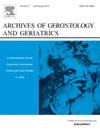COGNITIVE AND AFFECTIVE DISORDERS IN THE ELDERLY: A NEUROENDOCRINE STUDY
IF 3.5
3区 医学
Q2 GERIATRICS & GERONTOLOGY
引用次数: 0
老年人认知和情感障碍:一项神经内分泌研究。
在生理性和病理性脑老化过程中,认知和情感障碍通常伴随着可能参与情绪、学习和记忆控制以及下丘脑-垂体-肾上腺(HPA)轴调节的脑区域的显著形态和代谢变化。本研究的目的是研究25例老年痴呆患者和10例老年单极抑郁症患者血清皮质醇和脱氢表雄酮(DHEAS)的昼夜节律,并与21例老年和13例年轻对照进行比较。与年轻的对照组相比,健康和痴呆的老年受试者血清皮质醇的昼夜节律特征明显变平,夜间皮质醇水平明显升高。轻度抑郁的发生与老年痴呆受试者皮质醇平均水平的进一步升高有关,但与健康受试者无关。老年抑郁症患者夜间皮质醇水平升高的趋势也很明显。DHEAS分泌模式的下降明显与年龄相关,是痴呆和重度抑郁症的附加因素。轻度抑郁对DHEAS分泌无显著影响。皮质醇/DHEAS摩尔比被认为是反映脑甾体环境的良好指标,随着年龄的增长而逐渐增加,并与老年痴呆或轻微抑郁症状的发生有关。同样的比值在老年抑郁症患者中高于同龄健康对照组。总之,重度抑郁症的发生,甚至只是抑郁症状的出现,似乎放大了生理衰老中已经存在的肾上腺甾体激素分泌模式的变化。
本文章由计算机程序翻译,如有差异,请以英文原文为准。
求助全文
约1分钟内获得全文
求助全文
来源期刊
CiteScore
7.30
自引率
5.00%
发文量
198
审稿时长
16 days
期刊介绍:
Archives of Gerontology and Geriatrics provides a medium for the publication of papers from the fields of experimental gerontology and clinical and social geriatrics. The principal aim of the journal is to facilitate the exchange of information between specialists in these three fields of gerontological research. Experimental papers dealing with the basic mechanisms of aging at molecular, cellular, tissue or organ levels will be published.
Clinical papers will be accepted if they provide sufficiently new information or are of fundamental importance for the knowledge of human aging. Purely descriptive clinical papers will be accepted only if the results permit further interpretation. Papers dealing with anti-aging pharmacological preparations in humans are welcome. Papers on the social aspects of geriatrics will be accepted if they are of general interest regarding the epidemiology of aging and the efficiency and working methods of the social organizations for the health care of the elderly.

 求助内容:
求助内容: 应助结果提醒方式:
应助结果提醒方式:


